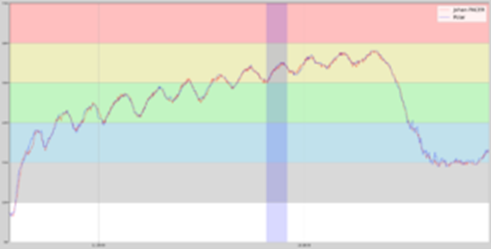The Interval Shuttle Run Test (ISRT) is a widely used physical test for team sports players. Clubs ranging from amateur to professional levels use this test to get insights into the physical fitness of the players. But what is the logic behind this test, and what kind of information can you get out of it? In this blog, we will provide answers to these questions.
Team sports, such as football and field hockey, are characterized by their intermittent nature: periods of low-intensity activity are interspersed by periods of high-intensity activity. Hence, players require a well-developed ability to perform these high-intensity activity, but they also need to be able to recover during the periods of lower-intensity activity. If players are able to sufficiently recover when they are walking or jogging throughout the match, they are still able to perform the decisive high-intensity sprints at the end of the match. Hence, a physical test for team sports players needs to incorporate both high and low-intensity intervals.
What is the isrt (interval shuttle run test)?
Before explaining what the Interval Shuttle Run Test is precise, we take one step back to the Shuttle Run Test. The Shuttle Run test is a well-known test for high-school students. During this test, participants have to run back and forth between lines which are placed 20m apart. The pace at which they have to run is indicated by a beep and increases throughout the test. The Interval Shuttle Run test is very similar to this test. However, based on the above-described characteristics of team sports, a few adjustments to the test were made to make it more specific for the testing of team sport players. One of the most pronounced differences is mentioned in the name: instead of the continuous nature of the Shuttle Run Test, the ISRT has intervals. This means that the players get 15 seconds of (active) recovery each time they have run for 30 seconds. Other differences are the higher starting speed of the ISRT (10km/h vs 8.5km/h) and a more rapid increase in speed towards 13km/h (1km/h vs 0.5km/h). When the threshold of 13km/h is reached during the test, the speed will increase with 0.5km/h per step. Next to the fact that these adjustments make the test more sport-specific, they also make the test more fatiguing. This, in turn, reduces the time it takes to perform the maximal test.
What information can you get out of interval shuttle run test?
The information you can get out of an ISRT is dependent on the type of test you perform. When you perform a maximal ISRT (i.e. running till exhaustion), the numbers of runs the players were able to perform can give you information about their intermittent endurance capacity. For example, it is known that there are differences between playing positions and their performance in the ISRT. Fullbacks and midfielders score better in this test than central defenders.
This corresponds with the more distances these players cover at higher intensities during a match compared with the central defenders. Hence, by analyzing the amount of runs players are able to perform during a maximal ISRT, you can already get insights into their ability to perform the high-intensity actions throughout the match. But analyzing the heart rate data of the players during these tests can give you even more specific information about the physical fitness of the players.

Figure 1: Typical pattern of the heart rate (and velocity) data of players during the ISRT
When a submaximal test is performed (i.e. 70% of the maximal runs the players were able to perform or a pre-determined number of runs), all information needs to be distracted from the heart rate data (Figure 1). When analyzing the heart rate data of the players, there is one very important aspect that needs to be taken into account. Heart rate is an individualistic measure, this means that you should only compare the heart rate results of one player over time (and you should never compare the heart rate results of one player to the results of another player). As can be seen in figure 1, the heart rate of players is increasing during the run-intervals of the ISRT, whereas during the rest-intervals, the heart rate is decreasing. Some players show a larger decrease in heart rate during the 15-second rest periods than other players. However, this does not mean that the recovery capacity of one player is better than the other player. Rather these differences are often indicative of differences in individual heart rate characteristics between players. Therefore, it is important to compare the heart rate results of one player over time, rather than to compare them to their teammates.
Which aspects can be analyzed?
What aspects of the heart rate data can be analyzed to get more specific information about the intermittent endurance capacity of the players? The most common aspects that are being analyzed are the heart rate recovery after the test, these include the decrease in heart rate in the first 15 seconds, the first minute, and the first two minutes after the test. The higher the decrease in heart rate, the better the recovery capacity of the players. Less known aspects that can be analyzed are the relative heart rate (i.e. percentage of the maximal heart rate) after 6 and 9 minutes in the test. For these aspects, the lower the relative heart rate, the better the fitness levels of the players.
If you want more information about the analysis of heart rate data or if you want to plan an ISRT for your team with the help of JOHAN’s products and analyses, contact JOHAN Sports for more information!
